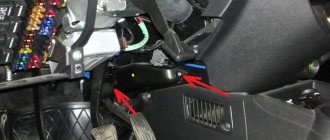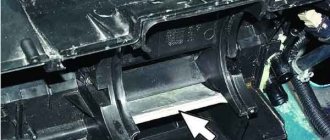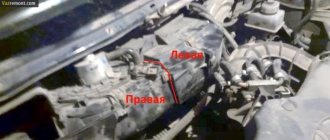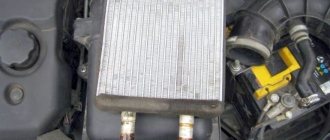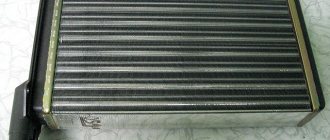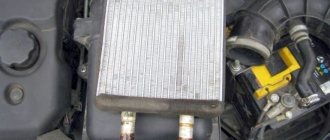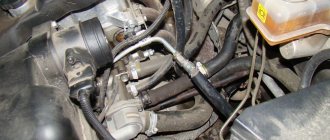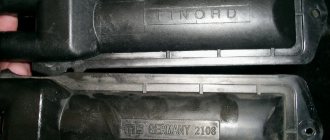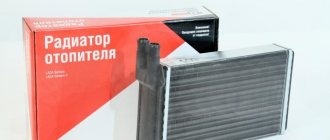How to replace the radiator of a Priora stove without air conditioning
In winter, as you know, car enthusiasts turn on the stove to avoid freezing. Its normal operation ensures a comfortable temperature inside the car, and this, in turn, is the key to safe driving. However, there are times when this unit stops supplying warm air. The reasons can be very different, for example, problems with the radiator. Many people, including owners of Lada Priora, both equipped with air conditioning and without it, encounter malfunctions of this kind.
In some cases, it will only take a minute to fix the problem because you just need to replace the blown fuse. But there are situations when more serious repair work, such as replacing a radiator, cannot be avoided. However, there is nothing particularly complicated here. Everything can be done with your own hands - you just need the appropriate desire and a little time.
Diagnostics of climate control Priors luxury equipment
Like all electronic control units (ECUs), the heater/air conditioning computer is diagnosed either with a portable scanner or with a full-fledged motor tester. It should be borne in mind that this system is controlled through a separate ECU called the comfort unit.
Just like standard diagnostics, the climate control system scan is connected via the OBD-2 diagnostic connector under the glove box. In general, these tests are carried out in a similar way to diagnosing an automatic heating system. With air conditioning features. That is, checking the actuators and sensors of this device.
How to remove the heater radiator on a Priora without air conditioning
How to flush the heater radiator without removing it
Since the beginning of production, AvtoVAZ has installed a heater from the “ten” (catalog number: 21110-8101012) on Prioras. The disadvantage of this design was that the heater radiator is removed towards the vacuum brake booster, which allows this to be done. As a result, the heater assembly has to be dismantled.
The procedure is as follows:
- Remove the wipers.
- Remove the frill (wind flap).
- Remove the soundproofing of the engine shield.
- Disconnect a bunch of connectors with wires.
- Unscrew the heater mountings.
- Divide the heater into two parts (left and right).
- Remove the right side of the heater (in the direction of travel).
- Move the left side to the side to gain access to the heater radiator.
- Drain the antifreeze.
- Replace the heater radiator.
The whole procedure took several hours. This is shown in more detail in the video:
There is another way to replace it. To gain access to the heater radiator, instead of the heater housing, it is necessary to remove the vacuum brake booster along with the brake pedal. This allows access to the left side of the heater (in the direction of travel) and to the radiator itself.
Video instruction:
Product delivery options
Note! Below are the shipping methods available specifically for this product. Payment options may vary depending on the shipping method. Detailed information can be found on the “Delivery and Payment” page.
Parcel by Russian Post
Available payment methods:
- Cash on delivery (payment upon receipt)
- Using cards Sberbank, VTB, Post Bank, Tinkoff
- Yandex money
- QIWI
- ROBOKASSA
Shipping throughout Russia. Delivery time is from 5 to 12 days.
Parcel by Russian Post 1st class
Available payment methods:
- Cash on delivery (payment upon receipt)
- Using cards Sberbank, VTB, Post Bank, Tinkoff
- Yandex money
- QIWI
- ROBOKASSA
Shipping throughout Russia. Delivery time – from 2 to 5 days. More expensive than regular delivery by Russian Post, approximately 50%. Parcel weight up to 2.5 kg
Express Parcel EMS
Available payment methods:
- Cash on delivery (payment upon receipt)
- Using cards Sberbank, VTB, Post Bank, Tinkoff
- Yandex money
- QIWI
- ROBOKASSA
Shipping throughout Russia. Delivery time – from 3 to 7 days. More expensive than regular delivery by Russian Post, approximately 100%.
Transport companies
Available payment methods:
- Using cards Sberbank, VTB, Post Bank, Tinkoff
- Yandex money
- QIWI
- ROBOKASSA
Delivery is possible to any locality where there is a representative office of the transport company. Delivery time – from 2 to 10 days. Sending large parcels is approximately 50% more profitable than by Russian Post.
Courier delivery in Togliatti
Available payment methods:
- Cash upon receipt
- Using cards Sberbank, VTB, Post Bank, Tinkoff
- Yandex money
- QIWI
- ROBOKASSA
Delivery time from 1 to 12 hours.
Replacing the heater radiator on a Prior
Chevrolet Cruze 2013 Heater Damper Repair Chevrolet Cruze 2013 Heater Blower Repair
replacing the heater radiator on a Prior
There was such a problem that antifreeze was leaking (under the hood, in the area of the interior heater radiator). Natural assumptions: a) the pipes are leaking b) the radiator itself is leaking. Once I already changed the heater radiator on a ten on my own.
The work was long and tedious, it seems that’s when I learned to swear. Now I had to do the same thing at Priory! And of course I went to the service center) in each one I asked how much it would cost to replace the heater radiator on a Priora with an air conditioner. In the first one they told me this: we’ll change it without any problems! aaaah! Heater radiator There, the floor of the car needs to be dismantled, we won’t take it on! In the second: it will cost 1500! and not now, but someday, when there is time! In the third: I won’t take it, although I’ll call you now (I don’t remember the name), maybe he’ll take it, he called, and he says I’ll take it! But it will be expensive, we’ll have to see what happens according to standard hours, we may have to defrost the air conditioner Aha! I filled it up at the beginning of summer! And I also decided not to mess with such specialists! And when my friend’s friend, a car mechanic and my penultimate hope, also moved away from the topic of solving my problem, saying no, I don’t want to go there, I had to despair)) First of all, I started looking for instructions on how to replace this device on the Internet! In between, I learned that Priors have 3 types of climate systems: 1) stove 2) Korean climate from HALLA 3) climate from Panasonic. So, each manufacturer developed the entire heater unit, including engines, filters, compressors, radiators, completely, turnkey! So even the cabin filter is different for everyone. I determined that my Conder belongs to the Halla company! Wherever I looked, I came across only one single instruction for replacing this thing in a heater without an air conditioner and printed it out! *First of all, I threw the instructions away! There are no coincidences in it! *The second one, after swearing a little, got to the radiator, disconnected the clamps and took it out! Even then I found out that the radiator was intact and it was dry and dry under it. So I just had to tighten the clamps! But I took it out, probably to amuse myself with the thought that all the work to replace it had been done! *The third one put everything back together! 2) Soft insulation of everything from the engine consists of 3 parts. Just remove the middle one! (it is held in place by 3 self-tapping screws on top / 3 screws along the edges / 2 nuts with a washer on the bottom (the work of unscrewing these nuts is the most difficult on the agenda! Although rather simply inconvenient!) hoses are attached to it with latches, we UNLOCK the pipes, we unscrew the screws and nuts 2.1) I removed the THICK PIPE (air filter pipe) going to the air filter so as not to interfere with photography.
It’s certainly more convenient without it, but you don’t have to take it off! 3) there is a foam rubber seal on the radiator pipes, remove it by pulling it up! 4) We see the radiator pipes; they have a plastic cap on them that covers the radiator. It is secured with 3 self-tapping screws (2 at the top along the edges / 1 at the bottom in the center) and unscrew it! 5) Now, to remove the heater radiator, you just need to loosen the clamps, remove the pipes (lift them up so that the antifreeze does not leak out) and PULL THE RADIATOR UP TO YOURSELF! Reassemble in reverse order! By the way, I added a couple more clamps! TOTAL: To change the heater radiator you need to unscrew 6 self-tapping screws, 3 screws and 2 nuts / loosen 2 clamps. For the first time and without rushing, it took 1.5 hours. AT THE SAME TIME I LUBRICATED THE GEARBOX (and the trapezoid mechanism) of the windshield wipers. To do this, I removed both top plastic covers (jabot) and removed the door wipers (if you are going to dismantle the trapezoid, you need to turn on the ignition + wipers and turn off the ignition, in the position when the wipers are raised up! I didn’t remove it) We unscrew the 3 screws on it, open it, remove the old grease / apply new one. Close it, tighten the screws, put on the protective bag.
Lubricate all the hinges of the trapezoid! (if, before removing, the wipers were left in the *up* position, the trapezoid can be removed by unscrewing only 2 nuts) Done. All that remains is to assemble it in reverse order. Article c. https://www.drive2.ru.
9-12-2013, 08:46, Category - Test drives
Replacement
Hyundai Accent silver Logbook Replacing the heater fan
As in the case of a conventional heater, a sign of a malfunction of the Priora stove with air conditioning that requires replacement of the radiator is fogging of the windshield and a strong smell of antifreeze (antifreeze) in the cabin. This is a clear sign that it is time to replace the radiator.
Radiator replacement
As with a regular Priora, it all starts with removing the frill and the walls between the stove and the engine compartment. This is the procedure already described.
Next comes a similar drain of the coolant. But then everything is a little simpler. There is no need to dismantle the entire heater to replace the radiator. It is enough to loosen the clamps securing the pipes to the radiator. Remove the hoses and unscrew the 3 fastening screws. And that’s all, the radiator of the Priora stove can be freely changed. He comes forward easily. Glue the foam seal and insert a new one into place. Secure the entire structure and install the protection in reverse order.
Radiator malfunctions and their consequences
A broken device poses a great danger to the entire cooling system, since its instability can lead to overheating of the power plant. The Lada Priora uses a standard combined cooling system, when the liquid system is supplemented by an air system. Thanks to this combination, it is possible to more effectively maintain the optimal engine temperature under various loads and operating modes.
There are not many malfunctions of this element as such. The main problem with the radiator is the occurrence of coolant leakage. This happens due to a violation of the integrity of the tubes caused by damage to the radiator. Another common problem is clogging of its inner surface. This can be determined due to the constant operation of the forced cooling fan.
The temperature drops, but rises quickly and causes the ventilation unit to turn on again, even when driving at high speed. This is due to the fact that the oncoming air flow cannot cool the coolant due to dirty plates. Contaminants can also be deposited on the inner walls of the radiator tubes, which will impede the circulation of antifreeze. And, as a result, the engine will begin to heat up excessively.
When the device is broken, the power unit overheats.
Causes of malfunctions
The main factors causing problems with the radiator are the following:
- wear of elements of a natural nature (any part sooner or later wears out and fails);
- mechanical impacts leading to damage and deformation;
- operating the engine in violation of the manufacturer's requirements and recommendations.
Breakdown can be caused, among other things, by the use of low-quality coolant, mixing antifreeze with other types of antifreeze, and the use of all kinds of sealants that can clog the pipes and affect the circulation of the coolant (coolant). At the same time, the human factor cannot be ignored when, due to incompetence in matters of radiator maintenance and repair, a part has to be replaced.
Often, simple dirt and poplar fluff that clog the plates can cause the engine to heat up. Due to systematic overheating, the fuel in the cylinders begins to detonate due to the increased temperature of the coolant. As a result, the cylinder head burns out, the block itself becomes deformed from high temperatures, and cracks appear. And ultimately, the destruction of the piston group and crank mechanism completes the picture. It's not far from a major, expensive engine overhaul.
You need to carefully monitor the condition of the cooling system and the radiator in particular.
Signs of trouble
Even a beginner can determine that there are some problems with the radiator. This does not require special knowledge. It is enough to understand in general terms the principle of operation of the cooling system of the Lada Priora.
We recommend: Top 3 cars for car ladies
Troubleshooting
| Symptoms | What are they related to? |
| On the instrument panel, the arrow of the coolant temperature indicator constantly approaches the red zone. | This provokes the inclusion of forced cooling and indicates engine overheating. |
| Constant overheating can also be determined by the deposit on the spark plugs. | During normal engine operation, the coating is sand-colored; when overheated, it is white. |
| It is necessary to carefully monitor the level of coolant in the expansion tank. | A sharp or gradual decrease in level will indicate the presence of a leak, which may be associated with a leak in the radiator. |
Low coolant levels will also lead to rapid overheating. It is easy to find a leak by characteristic smudges on the surface, as well as by the presence of antifreeze or antifreeze where the car is parked.
Replacing the heater radiator on a Priora without and with air conditioning. This is AvtoVAZ
- The heat exchange device is represented by a radiator, through which the external air entering the cabin is heated;
- A fan driven by an electric motor promotes air circulation in the cabin;
- Damper that regulates the flow of incoming cold air;
- Dampers that regulate and distribute the flow of incoming warm air into the cabin.
- Disconnect the vehicle from the battery;
- Now you can start removing the windshield trim;
- The windshield wiper arms will interfere with operation, so they need to be removed;
- You also need to remove the plastic fluid supply tubes to the injectors;
- To remove the decorative trim of the windshield, you need to unscrew the seven screws that secure it;
- After this, you can remove the hood seal;
- There is a screw installed in the middle of the lining that tightens both halves of the lining;
- Next, use a screwdriver to pry off the plugs that cover the screws, unscrew them and remove the trim from the body;
- After this, you should begin to remove the sound insulation of the engine compartment; to do this, you should unscrew the screws that secure it, and then remove the left and right linings;
- Now let's move on to the pipes going to the heater radiator. You should loosen the clamps and remove the pipes. Place a container under them, as antifreeze may spill. The removed pipes should be plugged in an accessible way;
- Next, you should disconnect all connectors with wires that go to the heater;
- After this you will need wrenches. Using a socket wrench set to “10” you should unscrew three nuts, and one nut will be used for a wrench “8”;
- The wiring harness interferes with removing the heater. You need to remove the holder and take it to the side along with the wires;
- Now the work will continue inside the car. You will need a “13” socket wrench to remove the bracket with the brake pedal, which then needs to be moved to the side;
- The heater is accessible and can be removed for repair and maintenance;
- To remove the radiator, you need to use a Phillips screwdriver to use three screws, after which it can be easily removed. In many cases, it is dirty, so it should be cleaned with a brush and blown with compressed air.
- Installation is carried out in reverse order.
- Remove the rubber seal from the windshield lining;
- After this, they begin soundproofing the engine compartment. Some screws are not easy to get to, be patient, be careful and everything will work out;
- Now you can begin to remove the foam gasket on the pipes;
- After this, you can remove the plastic radiator cap; to do this, you need to unscrew three screws;
- Once access to the pipes is available, you can begin to remove them. You should not completely drain the antifreeze from the system; you can substitute a small container and drain it from the heater radiator and expansion tank, and then plug the pipes.
AutoFlit.ru
Fan doesn't work
But sometimes another problem occurs with the Priora stove. The driver turns the heater switch, and in response there is silence. The electric motor is not working. What is the reason. There may be several of them:
- The fan motor burned out.
- The heater control unit has failed.
- The fan speed resistor has burned out.
- Broken electrical wiring.
The easiest way to determine if a resistor is broken. In this case, only the maximum speed is turned on, and the stove does not respond to other positions of the handle.
The control unit is checked either by computer diagnostics or by a simple replacement. There are no other options.
The condition of the electric motor can be determined by checking with a test lamp. It is enough to remove the top frill and gain access to the motor connector. Disconnect this connector and insert a test lamp instead of the chip going to the fan. When you turn on the stove handle, the light should light up if the unit and wiring are working properly. If there is no signal, start checking the wires sequentially. If the lamp lights up, replace the electric motor.
Replacing the motor
Although Hallo and Panasonic fan electric motors differ in size and installation point, they have one thing in common. Their location is in a vertical position. This allows you to dismantle them without removing the entire heater. As with a standard heater, the heater fan motor on a Priora with air conditioning is secured with 3 screws.
So, replacement. As in the case of a radiator, first of all you need to open access to the stove. That is, remove the frill and protection. Then disconnect the electrical connector. Now just unscrew the 3 fastening screws and remove the fan with the motor. That's it, you can install a new unit in its place. But this is only for the Hallo heater. With the Panasonic compressor, everything is somewhat more complicated. The fact is that it is also separated from the engine compartment by a plastic casing. According to factory documentation, it is necessary to remove the entire heater to replace the electric motor. And this is draining and refilling freon. But our craftsmen found a way out.
Cut the protection at the narrowest point approximately in the middle of the compartment and remove it by unscrewing 2 fasteners. After this, access to the part being replaced is open. Sometimes, however, in most cases, the engine mount prevents you from pulling out the motor. Don't panic. This problem can be solved by disassembling the motor on site. That is, separate it into 2 halves and pull them out separately. Then insert a new one using the same method.
But still, just in case, before replacement, it is better to consult with car service specialists in advance about possible refilling of the air conditioner with freon in case of damage. This is to replace the motor. But with a radiator, such problems, as a rule, do not happen.
Video on the topic of replacing the radiator of a Priora stove with air conditioning:
Main aspects of repair
If the fan does not work or the stove generally stops working, then you need to understand that the repair process is a rather labor-intensive procedure. Before you remove the heater radiator on a Priora or how to remove the fan, you need to do diagnostics. First, the functionality of the thermostat is checked. If the lines connected to the device are warm, then the part is working.
If the fan does not work, first of all you need to check its contacts. Replacing the stove fan does not always solve the problem, especially if it involves oxidation of the contacts. Sometimes simply cleaning the connector from the device is enough to solve the problem. You can always remove the heater fan, but the heater fan does not fail very often. If the stove blows only at maximum speed, the stove rotation speed resistor has burned out.
The main differences between the Priora stove with air conditioning and the standard one
The main feature of this device is the presence in the air duct of a heater, an air conditioner evaporator radiator, which cools the air passing through it.
Operating principle of the air conditioner
All cars equipped with these devices have approximately the same set of components. It includes the following elements:
- Control block.
- Relays and fuses.
- Air conditioning radiator with fan.
- Compressor with electric coupling.
- Evaporator.
- Aluminum tubes for connection.
- Sensors and wires.
The main feature of this gas is its ability to lower temperature when strongly compressed. That is, the higher the pressure in the system, the lower the temperature during evaporation. This is such an interesting thing. In general, when turned on, the compressor pumps pressure into the evaporator, located in the heater housing in the path of the air sucked in by the engine. The heated gas goes through the return pipe to the radiator, located in front of the main heat exchanger of the cooling system. And from there, under pressure, again into the evaporator. The air conditioner is turned on from the control panel of the unit, with a button built into the heater mode handle.
Differences
It is the presence of the evaporator that dictates the requirements for the location of the stove components. That is why the electric motor of the Priora heater is located not vertically, as on a standard stove, but horizontally. And the Priora cabin filter takes a vertical position instead of a horizontal one. There is a separate article about this on replacing the Priora cabin filter.
Radiator of the Priora stove with air conditioning
It was also positioned somewhat differently. The difference is that it does not go towards the vacuum brake booster, as on a simple Priora, but forward. That is, in the direction of the car engine. All this is done so that you do not have to dismantle the entire stove to replace the unit.
Heater fan
The engine on such stoves, as already mentioned, is located vertically. One detail. If a Panasonic air conditioner is installed, then its electric motor is located on the right side of the stove (along the direction of the car). But on the Hallo system, on the left. Next to the radiator. The Halo air conditioner motor is slightly smaller than the Panasonic motor.
Air conditioner evaporator
And, of course, the evaporator radiator. It is installed in the right half of the heater, right at the air inlet
It is its presence that requires special care when repairing and replacing any part of the climate control system
Comments and reviews
After replacing and flushing the cooling system on the Priora, the heater blows cold air... There is no air in the system. I don’t understand what happened.
No matter how good a car is, parts break down from time to time. This also applies to the radiator (heat exchanger) of the Priora stove. What to do in this case? On the first car models, these parts were made of copper and bronze. In the event of a leak or other breakdown, they were soldered. Now they are made of plastic and aluminum. So there is no point or possibility to repair them. They can only be replaced.
Well, for the radiator of a standard Priora stove, the owner himself, who knows how to use tools competently, can independently replace it. You just need to carefully read the presented article.
Radiator replacement
To work, you will need a standard set of tools, which includes socket wrenches 10 and 13, side cutters, a Phillips screwdriver, and a wrench 8. In both cases, you will have to disconnect the heating system hoses; the remaining coolant will pour out of them, so immediately place containers under the pipes heater Then the liquid can be returned to the system.
With air conditioning
- First of all, we need to remove the rubber seal of the windshield to gain access to the parts;
- Let's move on to soundproofing the engine shield. We need to dismantle its middle part, having previously removed the hoses from the mounts. The sound insulation is secured at the bottom with 3 screws, 2 nuts and a washer, and at the top with 3 self-tapping screws. It is recommended to use a tool extension as some fasteners may be difficult to reach;
- After dismantling the protection, you will see a foam seal that covers the heater radiator;
- To remove the cover, we need to unscrew 3 screws - 1 you will find in the middle, and 2 others - along the edges;
- We reached the pipes. To remove them, we need to loosen the clamps and lift the pipes up. Be careful not to tilt the hoses down;
- Pull the heater core towards you until it comes out of the fastenings.
As you can see, dismantling the radiator in a Priora with air conditioning does not require draining the antifreeze. Coolant will only come out of the expansion tank and the heat exchanger itself. Removing the radiator in a VAZ 2170 with Panasonic air conditioning follows the same scheme, only a few fasteners may differ. Now you can replace your worn-out heater with a new one!
Without air conditioning
- Work begins by disconnecting the negative terminal of the battery. We remove the windshield trim along with the windshield wiper arms, as these elements will interfere with operation;
- The next step is to remove the coolant supply pipes to the engine injectors;
- The windshield trim is held in place by seven screws. Unscrew it to completely remove the element;
- Now we move on to the hood seal, in its center you will find a tightening screw - unscrew it;
- The engine noise insulation closes the passage to the heater system - pry up the plugs with a flat screwdriver and unscrew the plugs;
- We unscrew the screws and dismantle the sound insulation. Remove both covers;
- Let's move on to the radiator pipes. We loosen the clamps and dismantle them, having prepared a container for antifreeze in advance. Plug the pipes so as not to drain all the antifreeze;
- You need to remove all the wiring that goes to the stove;
- Next, remove the wire holder and take it to the side, now we go to the Priora’s interior;
- Armed with a 13mm wrench, unscrew the bracket fastenings along with the brake pedal. We move the details to the side;
- We unscrew 3 screws and gain access to the radiator;
- Replacement is carried out in reverse order.
Video instructions for replacing a leaking stove:
How to replace a stove radiator yourself without an air conditioner
What will be needed for replacement? First of all, the following tools:
- Screwdrivers, figured and flat.
- Wrenches for 8 and 10. (preferably heads with a wrench.)
- Thin pliers for removing clamps.
And, of course, some materials and devices:
- Container for coolant from the system.
- New radiator.
- Foam rubber adhesive strips for the radiator of the Priora stove.
- 2 liters of coolant. (same brand as in the system.)
- Rags.
Having prepared such an arsenal, you can begin this interesting operation of replacing the heat exchanger.
Process description
Place the car level. This is necessary to completely drain the coolant from the radiator of the Priora stove. Place a container for liquid under the bottom of the car. It must be installed in the area of the radiator drain hole of the cooling system. On the right side (along the direction of the car, or on the left, if you stand near the hood). Next you need:
- Unscrew the screw cap and allow the liquid to drain. When the pressure weakens, open the cap of the expansion tank. Wait for the drain to drain and tighten the plug. Disconnect the negative battery terminal. You can begin dismantling the protection. It's called frill.
- First, the windshield wipers are removed. Using a 13mm wrench, unscrew the fastening nuts and remove the brush holders. After this, remove the rubber seal.
- Unscrew the fastening screws. There are 6 of them on top and 7 along the bottom edge. Now remove both halves of the plastic frill. After unscrewing the fasteners, remove the fabric protection of the glass niche in which the stove is installed.
Now comes the most crucial moment. Most craftsmen, when replacing this part, immediately disconnect the pipes going to the radiator of the Priora stove. However, there is a risk of dousing the heater parts with coolant. There is a more interesting and safer option.
Removing the stove
Now that the frill and protection have been removed, access to the heater is completely open. First of all, you need to disconnect the electrical connectors:
- Micromotor gearbox for damper drive. 2 connectors.
- Electric fan. 1 connector.
- Resistor. 1 connector.
Now unscrew the fastening of the heater body to the car body. One 10mm nut secures the eye on the stove body to the right wing. 8 secures the top to the stud at the top. And two nuts at the bottom.
Once the fasteners are removed, the fun begins. Using a flat screwdriver, remove the 3 screws securing the radiator to the body
You need to act carefully so as not to break off the side, thin pressure relief pipe. After that, unscrew the screws holding the 2 parts of the heater housing
Move the left part with the fan motor a little to the left, disconnecting them, and pull it out.
After this, you can begin to remove the second half with the radiator. Hold the pipes with your hand and begin to remove the body to the left. When it comes off, set it aside. After releasing the clamps from the pipes, remove them from the radiator.
Necessarily! Place a rag under the radiator, as there is always some liquid left and you should not pour it on the engine compartment.
Installation (replacement) of a new radiator
There are two options here. You can simply replace it by putting the part in place of the old one, before installing the housing. But it is better to install the radiator in the removed half before attaching the pipes.
Important! Be sure to cover the radiator with foam tape! This creates a safety cushion for the part. Having decorated the heat exchanger of the stove with foam, install it in the housing niche and secure it with screws
Place the half in place and secure all 3 pipes in place. Tighten the clamps
Having decorated the heat exchanger of the stove with foam, install it in the niche of the housing and secure it with screws. Place the half in place and secure all 3 pipes in place. Tighten the clamps.
Carefully reassemble the heater in reverse order. Add coolant to normal level. Start the engine and wait for the cooling fan to operate. Press the accelerator pedal and hold the speed at about 2,000 rpm for a couple of minutes. This is necessary to eliminate a possible air lock. Turn on the heater and check its operation in all modes. All! Well, the necessary work has been done.
Video on the topic of replacing the heater radiator on a Priora without air conditioning.
- Removing the CV joint
- How to determine a CV joint failure
- Computer diagnostics of the Priora heater control unit
- How to fix the stove in a Lada Priora car
How does the radiator in Priora work and what functions does it perform?
As stated above, in Lada Priora and other domestic and foreign cars the cooling radiator optimizes the temperature of the liquid.
Note that the radiator does not have any effect on the cooling system when the so-called cold engine is started. It does not start working at all until the car engine is sufficiently warmed up. When the temperature reaches a certain point, in particular on the domestic Lada Priora this figure is 85-90 degrees, the thermostat opens and the filled antifreeze circulates through the cooling system. When the “engine” operates at high speeds, in particular, when the car is moving at low speed, and the cooling radiator is unable to cope with its task, and the temperature of the power plant begins to rise again, and then the fan turns on, which forcibly cools the antifreeze, located in the radiator at this moment.
The basic radiator on LADA Priora is made of parts made of brass. This material has high thermal conductivity. The core of the device and its middle part are a kind of plastic structure through which special tubes pass, which are connected to the plates by soldering. The coolant passing through the core of the device is distributed into several streams that run separately. This system allows antifreeze to be cooled much more efficiently.
The radiator tanks are connected to the system by pipes made of rubber. The lower reservoir is equipped with a tap, which makes it easier to drain old antifreeze during replacement. There is also a special tap on the cylinder block. From here the coolant can be drained from the water jacket of the power unit. In general, the design of the heat exchanger is quite simple, but very effective.
Lada Priora Sedan ALTAIR Logbook Heater radiator leaking
Hi all! I haven’t written anything for a long time, and there wasn’t really anything, because I was happy with the machine and there were no problems with it! Until recently. One evening, while driving around the area, I smelled antifreeze. I opened the hood and didn’t notice anything special, just that the level in the barrel had gone down. I topped up the antifreeze and drove on, drove like this for several days, and the antifreeze kept leaving the barrel. I looked for a leak but couldn’t find it, and then one evening I was driving to friends, it started to smell like antifreeze again, I stopped, opened the hood, and there was a fountain! In short, it was leaking from the side of the stove, at first I thought the hose was a thin drip! But after disassembling all the casing I realized that this is not so! The leak was visible in small streams from the heater radiator. The next day, after printing out smart papers for the car, I went to the garage to remove the stove. It didn’t take much work for me, but it’s a lot for a patient to unscrew all sorts of little things! Having disassembled and removed everything, I was amazed by the amount of garbage! Having removed and washed everything, I saw the factory vibration isolation! I looked at it and looked and remembered that I had a sheet of vibra lying around in my garage, left over from gluing the floors and roof! Without hesitation, I rolled everything up with a vibrator, it won’t be superfluous! I disassembled the stove and washed it thoroughly, each part separately! Right now I’m still thinking about how to make a different cabin filter there, because I tried installing the original one on the removed stove and it’s of little use, because there are so many holes through which it’s not like dust can fly through, you can fill the stove full of leaves! And I almost forgot, I completely removed the wiper trapezoid, disassembled it and filled it with new grease, the wipers are installed on a bracket, having unscrewed both brackets, I decided to improve them too, because... They were rusty, without hesitation, I washed them of rust and sprayed them with gold paint, which had been lying around in my garage for a long time, you can’t see them there anyway, but they will rust less! Well, below is a photo of all this!
Replacing the heater radiator VAZ 2110
- Old style heater (until September 2003)
- New model heater (after September 2003)
- You can drain some of the antifreeze from the engine block. Unscrew the cap of the expansion tank (so that the pressure drops) and unscrew the drain plug, which is located behind the ignition module (unscrew it and put it aside). About 4 liters of antifreeze should come out of the previously placed bucket (if it’s clean, you can refill it later).
- And you can only drain it through the expansion tank. We remove the hose from the stove and pour out about 1 liter of antifreeze. Next, remove this rubber pipe (so as not to interfere) by loosening the three clamps:
The main causes of radiator malfunctions
We list the most common factors causing malfunctions in the radiator:
- The power unit is operated in serious violation of the manufacturer's regulations.
- All kinds of mechanical influences can lead to deformation and damage.
- The operational period of the radiator elements has ended.
In addition to the above, the use of low-quality coolant in the car also leads to breakdowns, also when the owner of a Lada Priora mixes antifreeze and antifreeze, uses sealant, and so on. The so-called human factor cannot be excluded in this matter, when it is necessary to change one or another part due to illiteracy in the matter of repair work and maintenance of the radiator.
Overheating of the power plant is also caused by dirt clogging the radiator fins, poplar fluff and insects getting there. When regular overheating occurs, the fuel in the cylinders begins to detonate, as a result, the cylinder head burns out, and the block itself may undergo deformation and cracks may form on it. As a result, everything will lead to the destruction of the crank mechanism and piston group. And it is not surprising that because of all this, the car owner will have to undergo an expensive engine overhaul.
It is necessary to be responsible and attentive to the condition in which the cooling radiator is located.
Removing the stove Lada Priora VAZ 2170, 2171, 2172
| You will need: an “8” wrench, “10”, “13” socket wrenches (head), a Phillips-blade screwdriver, side cutters. |
| 1. Disconnect the wire from the negative terminal of the battery. |
| 2. Remove the windshield frame lining (see “Windshield frame lining”) and the soundproofing upholstery of the engine compartment (see “Soundproofing the engine compartment”). |
| 3. Loosen the clamps... |
| 6. ...and disconnect the heater fan wiring harness connector.
| 8. Cut the clamp securing the wiring harness to the heater.
| 11. Remove and move aside the wiring harness holder along with the harness.
| 13. Remove the heater from the vehicle.
| 15. Disconnect the heater housing...
| 17. ...and then the right side of the heater housing.
Body MalfunctionsWindshield frame liningsSoundproofing of the engine compartmentFront bumperRear bumperFendersFront fenderSill platesHood (removal)Hood lockHood lock cableTrunk lidTrunk lid lockFront door trimFront door lockDoor opening limiterFront door glassFront window lifterFront door removalRear door trimRear door lockExternal New rear door handle Rear door glass Rear window lift Removing the rear door Removing the seats Replacing seat belts Outside mirror Rear view mirror interior Sun visors Handrails Steering column trim Floor tunnel linings Body pillar linings Luggage compartment shelf Sill linings Removing the dashboard Disassembling the dashboard Heater Removing the heater Heater radiator Replacing the windshield and rear window How to polish the body Anti-corrosion treatment |
